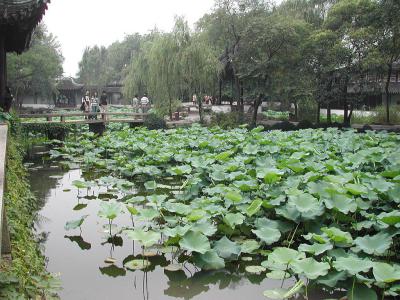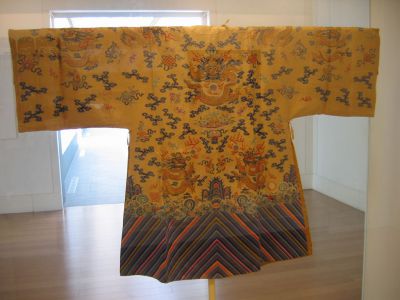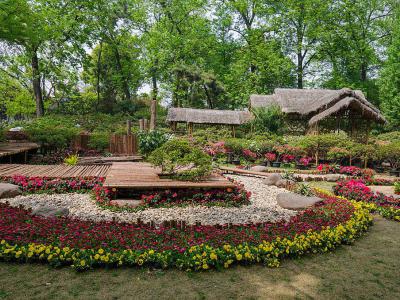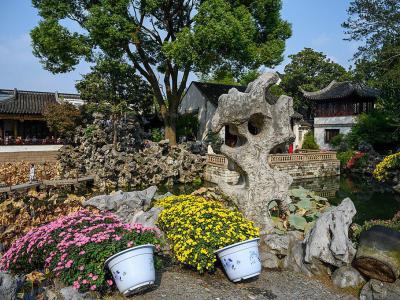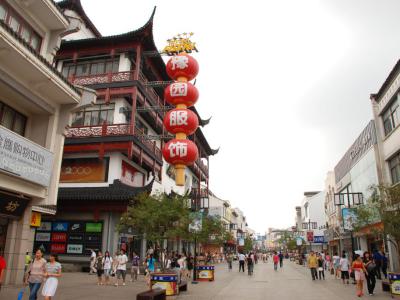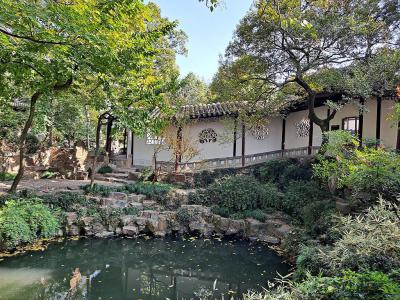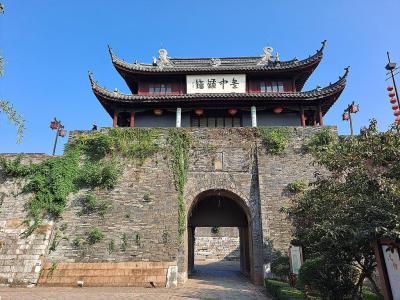Suzhou Introduction Walking Tour (Self Guided), Suzhou
"Above there is heaven; below there is Suzhou (and Hangzhou)." Often spoken of in conjunction with Hangzhou, another picturesque city in China, Suzhou is located in the eastern part of the country and is colloquially referred to as the "Water Town of the East," renowned for its waterways and classical gardens, together creating an idyllic setting.
As the cradle of Wu culture, the city boasts a rich heritage dating back to the Zhou period (the longest dynastic regime in Chinese history, from 1046 BC to 256 BC). The legendary Zhou lord Taibo established the state of Wu in the 11th century BC, fostering agriculture and irrigation skills among the locals. This laid the foundation for what would become Suzhou.
The present name, "Suzhou", which translates to "Su Prefecture," is derived from the Sui dynasty, in 589 AD, with "Su" being a contraction of the old name "Gusu," signifying a "Satisfied place" in the Old Yue language. The term "zhou" originally referred to a province or county but was often used to denote the capital of such regions.
Suzhou's importance grew further when the Grand Canal was completed, establishing it as a hub for trade. During the Tang dynasty, in 825 AD, poet Bai Juyi constructed the Shan Tang Canal (better known as "Shan Tang Street"), connecting the city with Tiger Hill.
Over the years, Suzhou saw periods of turmoil, including the Taiping Rebellion, but it rebounded to prosperity. Suzhou became a vital source of tax revenue, overseeing the Yangtze shoals that later became part of Shanghai. In the late 19th century, Suzhou opened to foreign trade, attracting expatriates and witnessing the rise of its silk industry and publishing sector.
Despite facing destruction during World War II and Japanese occupation, Suzhou's historical sites, such as the Humble Administrator's Garden and the Lingering Garden, underwent restoration in the early 1950s, preserving the city's rich heritage.
Today, Shan Tang Street and Guan Qian Street beckon with their bustling marketplaces, where one can discover a myriad of local delicacies, souvenirs, and cultural treasures. The Suzhou Silk Museum is another must-visit destination, providing insights into the city's illustrious silk industry, which has thrived for centuries.
As you explore Suzhou's enchanting attractions, you are bound to get an experience like no other. Intrigued by the allure of Suzhou? Embark on a self-guided journey to this captivating city and witness its historical marvels and cultural treasures firsthand.
As the cradle of Wu culture, the city boasts a rich heritage dating back to the Zhou period (the longest dynastic regime in Chinese history, from 1046 BC to 256 BC). The legendary Zhou lord Taibo established the state of Wu in the 11th century BC, fostering agriculture and irrigation skills among the locals. This laid the foundation for what would become Suzhou.
The present name, "Suzhou", which translates to "Su Prefecture," is derived from the Sui dynasty, in 589 AD, with "Su" being a contraction of the old name "Gusu," signifying a "Satisfied place" in the Old Yue language. The term "zhou" originally referred to a province or county but was often used to denote the capital of such regions.
Suzhou's importance grew further when the Grand Canal was completed, establishing it as a hub for trade. During the Tang dynasty, in 825 AD, poet Bai Juyi constructed the Shan Tang Canal (better known as "Shan Tang Street"), connecting the city with Tiger Hill.
Over the years, Suzhou saw periods of turmoil, including the Taiping Rebellion, but it rebounded to prosperity. Suzhou became a vital source of tax revenue, overseeing the Yangtze shoals that later became part of Shanghai. In the late 19th century, Suzhou opened to foreign trade, attracting expatriates and witnessing the rise of its silk industry and publishing sector.
Despite facing destruction during World War II and Japanese occupation, Suzhou's historical sites, such as the Humble Administrator's Garden and the Lingering Garden, underwent restoration in the early 1950s, preserving the city's rich heritage.
Today, Shan Tang Street and Guan Qian Street beckon with their bustling marketplaces, where one can discover a myriad of local delicacies, souvenirs, and cultural treasures. The Suzhou Silk Museum is another must-visit destination, providing insights into the city's illustrious silk industry, which has thrived for centuries.
As you explore Suzhou's enchanting attractions, you are bound to get an experience like no other. Intrigued by the allure of Suzhou? Embark on a self-guided journey to this captivating city and witness its historical marvels and cultural treasures firsthand.
How it works: Download the app "GPSmyCity: Walks in 1K+ Cities" from Apple App Store or Google Play Store to your mobile phone or tablet. The app turns your mobile device into a personal tour guide and its built-in GPS navigation functions guide you from one tour stop to next. The app works offline, so no data plan is needed when traveling abroad.
Suzhou Introduction Walking Tour Map
Guide Name: Suzhou Introduction Walking Tour
Guide Location: China » Suzhou (See other walking tours in Suzhou)
Guide Type: Self-guided Walking Tour (Sightseeing)
# of Attractions: 9
Tour Duration: 2 Hour(s)
Travel Distance: 4.6 Km or 2.9 Miles
Author: leticia
Sight(s) Featured in This Guide:
Guide Location: China » Suzhou (See other walking tours in Suzhou)
Guide Type: Self-guided Walking Tour (Sightseeing)
# of Attractions: 9
Tour Duration: 2 Hour(s)
Travel Distance: 4.6 Km or 2.9 Miles
Author: leticia
Sight(s) Featured in This Guide:
- Classical Chinese Garden
- Shan Tang Street
- Suzhou Silk Museum
- Humble Administrator's Garden
- Suzhou Museum
- Lion Grove Garden
- Guan Qian Street
- Great Wave Pavilion (Canglang Pavilion)
- Pan Gate
1) Classical Chinese Garden (must see)
The Classical Chinese Garden in Suzhou offers a refined introduction to one of China’s most celebrated artistic traditions. Developed over centuries by scholars, poets, and officials, these gardens were designed as private retreats that balanced nature, architecture, and imagination. Suzhou became a renowned centre for this craft during the Ming and Qing dynasties, when garden building reached an extraordinary level of sophistication. Today, several of these historic ensembles survive as UNESCO-listed sites, each illustrating how water, stone, plants, and pavilions were arranged to evoke the moods of famous landscapes and the ideals of classical literature. Their measured scale reflects the gardens’ original purpose: not grandeur, but the cultivation of the mind.
Visitors will encounter a distinctive aesthetic shaped by winding corridors, quiet courtyards, and artfully framed views. Pools mirror the surrounding halls and terraces, while scholar’s rocks create dramatic silhouettes that anchor the scene. Seasonal plants—bamboo, pine, plum, lotus—were chosen not only for beauty but also for symbolic meaning, reinforcing themes of resilience, purity, and harmony. Inside the pavilions, delicate latticework and calligraphic plaques recall the scholarly world that once animated these spaces. Many gardens also contain small theatres, study rooms, and furnished chambers that help convey the rhythm of daily life in these refined settings.
Exploring Suzhou’s classical gardens offers more than a sequence of picturesque scenes. It provides insight into a cultural philosophy that valued measured living and the contemplative pleasure of crafted nature. For travellers, they remain among the city’s most memorable places to slow down and appreciate China’s enduring artistic legacy.
Visitors will encounter a distinctive aesthetic shaped by winding corridors, quiet courtyards, and artfully framed views. Pools mirror the surrounding halls and terraces, while scholar’s rocks create dramatic silhouettes that anchor the scene. Seasonal plants—bamboo, pine, plum, lotus—were chosen not only for beauty but also for symbolic meaning, reinforcing themes of resilience, purity, and harmony. Inside the pavilions, delicate latticework and calligraphic plaques recall the scholarly world that once animated these spaces. Many gardens also contain small theatres, study rooms, and furnished chambers that help convey the rhythm of daily life in these refined settings.
Exploring Suzhou’s classical gardens offers more than a sequence of picturesque scenes. It provides insight into a cultural philosophy that valued measured living and the contemplative pleasure of crafted nature. For travellers, they remain among the city’s most memorable places to slow down and appreciate China’s enduring artistic legacy.
2) Shan Tang Street (must see)
Shan Tang Street, one of Suzhou’s most atmospheric historic corridors, offers visitors a vivid sense of the city’s old water-town character. Established in the mid-9th century during the Tang Dynasty, the street originally formed part of a canal route linking the city centre with the famous Tiger Hill. Over time, it developed into a lively commercial and cultural district, where boatmen, merchants, scholars, and local residents shaped a neighbourhood known for its elegant bridges, riverside houses, and enduring traditions. Walking here gives travellers a glimpse into how Suzhou once functioned as a city built around waterways, with daily life unfolding along narrow lanes and wooden docks.
Today, Shan Tang Street preserves this deep historical charm while offering a welcoming atmosphere for modern visitors. Whitewashed homes with dark-tiled roofs line both sides of the canal, accompanied by stone steps, arched bridges, and small courtyards that recall Suzhou’s classical architectural rhythm. Many buildings now host teahouses, craft shops, and family-run restaurants, allowing travellers to enjoy regional flavours, traditional opera performances, and locally made handicrafts. As daylight fades, lanterns appear along the water’s edge, creating reflections that highlight the quiet beauty of the canal and its centuries-old setting.
A stroll along Shan Tang Street provides a balanced mix of history, daily culture, and scenic charm. The route between the bustling sections near the city centre and the more tranquil stretches toward Tiger Hill reveals how the district has grown yet remained connected to its origins. For many visitors, it becomes one of Suzhou’s most memorable places to experience the spirit of the old city.
Today, Shan Tang Street preserves this deep historical charm while offering a welcoming atmosphere for modern visitors. Whitewashed homes with dark-tiled roofs line both sides of the canal, accompanied by stone steps, arched bridges, and small courtyards that recall Suzhou’s classical architectural rhythm. Many buildings now host teahouses, craft shops, and family-run restaurants, allowing travellers to enjoy regional flavours, traditional opera performances, and locally made handicrafts. As daylight fades, lanterns appear along the water’s edge, creating reflections that highlight the quiet beauty of the canal and its centuries-old setting.
A stroll along Shan Tang Street provides a balanced mix of history, daily culture, and scenic charm. The route between the bustling sections near the city centre and the more tranquil stretches toward Tiger Hill reveals how the district has grown yet remained connected to its origins. For many visitors, it becomes one of Suzhou’s most memorable places to experience the spirit of the old city.
3) Suzhou Silk Museum (must see)
The Suzhou Silk Museum offers an engaging look at one of China’s most renowned traditions, tracing the story of silk production in a city long celebrated for its craftsmanship. Suzhou has been a major centre of sericulture for over two thousand years, and the museum presents this legacy with a clear, well-structured journey through the art, culture, and technology behind silk. Its exhibitions highlight the region’s fertile mulberry fields, the development of weaving techniques, and Suzhou’s role as a major supplier along historic trade routes. Together, these displays set the stage for understanding how silk shaped local life, from agriculture to fashion and commerce.
Inside, visitors can observe traditional tools, rare fabric samples, and beautifully preserved garments that demonstrate the refinement Suzhou artisans achieved across dynasties. Demonstration areas show the delicate steps of spinning and weaving, offering an opportunity to see patterns and textures take shape before the final cloth is dyed or embroidered. Contemporary displays add another layer, showing how silk artistry continues to evolve through modern design and textile innovation. The museum also includes a small garden and resting areas that reflect Suzhou’s aesthetic values, balancing education with a calm, reflective atmosphere.
A visit to the Suzhou Silk Museum provides a concise yet vivid introduction to a craft that helped define the city’s cultural identity. It is an ideal stop for travellers interested in history, fashion, or traditional Chinese arts, offering both context and close-up encounters with one of the world’s most enduring luxury materials.
Inside, visitors can observe traditional tools, rare fabric samples, and beautifully preserved garments that demonstrate the refinement Suzhou artisans achieved across dynasties. Demonstration areas show the delicate steps of spinning and weaving, offering an opportunity to see patterns and textures take shape before the final cloth is dyed or embroidered. Contemporary displays add another layer, showing how silk artistry continues to evolve through modern design and textile innovation. The museum also includes a small garden and resting areas that reflect Suzhou’s aesthetic values, balancing education with a calm, reflective atmosphere.
A visit to the Suzhou Silk Museum provides a concise yet vivid introduction to a craft that helped define the city’s cultural identity. It is an ideal stop for travellers interested in history, fashion, or traditional Chinese arts, offering both context and close-up encounters with one of the world’s most enduring luxury materials.
4) Humble Administrator's Garden (must see)
The Humble Administrator’s Garden stands as one of Suzhou’s most celebrated classical gardens, offering a calm, carefully composed landscape that reflects centuries of Chinese aesthetic tradition. Its origins date to the early 16th century, when a retired imperial official, Wang Xiancheng, transformed former monastery grounds into a private retreat centered on water, poetry, and a scholar’s quiet search for balance. The garden later passed through several owners and renovations, each adding new layers to its design while preserving its emphasis on harmony between architecture and nature. Today, it is recognized as a UNESCO World Heritage Site and remains a defining masterpiece of Jiangnan garden culture.
Visitors will find that water forms the heart of the layout, with winding ponds, reflective surfaces, and stone bridges shaping the garden’s rhythm. Pavilions, corridors, and terraces appear in deliberate sequences, creating shifting views that reveal different moods as you walk. Ancient trees, bamboo groves, and sculpted rockeries enhance the sense of depth, while calligraphic plaques and historic structures recall the scholarly life that once unfolded here. The eastern, central, and western sections each offer distinct atmospheres, from open, tranquil vistas to more intimate, enclosed corners.
Exploring the Humble Administrator’s Garden provides a clear look into how traditional Chinese garden design aimed to distill the natural world into an idealized space for reflection. Its lasting beauty lies not only in individual scenes but in the thoughtful transitions that guide visitors from one setting to another, encouraging a slower pace and a deeper appreciation of Suzhou’s cultural heritage.
Visitors will find that water forms the heart of the layout, with winding ponds, reflective surfaces, and stone bridges shaping the garden’s rhythm. Pavilions, corridors, and terraces appear in deliberate sequences, creating shifting views that reveal different moods as you walk. Ancient trees, bamboo groves, and sculpted rockeries enhance the sense of depth, while calligraphic plaques and historic structures recall the scholarly life that once unfolded here. The eastern, central, and western sections each offer distinct atmospheres, from open, tranquil vistas to more intimate, enclosed corners.
Exploring the Humble Administrator’s Garden provides a clear look into how traditional Chinese garden design aimed to distill the natural world into an idealized space for reflection. Its lasting beauty lies not only in individual scenes but in the thoughtful transitions that guide visitors from one setting to another, encouraging a slower pace and a deeper appreciation of Suzhou’s cultural heritage.
5) Suzhou Museum
The Suzhou Museum offers a distinctive introduction to the city’s artistic heritage, blending ancient culture with contemporary design. Established in 1960 and completely reimagined with a new building in 2006, the museum is one of Suzhou’s most celebrated cultural institutions. Its location near the Humble Administrator’s Garden and the old city moat places it within one of the most historic quarters of Suzhou, where traditional canal-side life meets centuries of craftsmanship. The museum’s architectural identity is central to its appeal: designed by the renowned architect I. M. Pei, who was born in Suzhou, designed the building to combine clean geometric lines with motifs inspired by classical Chinese gardens. White walls, dark gray trim, and carefully arranged courtyards create a calm environment that echoes the city’s long tradition of literati aesthetics.
Inside, the museum presents a broad survey of Suzhou’s cultural legacy. Visitors encounter artifacts ranging from Neolithic pottery to exquisite Ming and Qing dynasty paintings, calligraphy, jade, and lacquerware. The collections highlight Suzhou’s reputation for refinement and artistry, especially in areas such as silk production, wood carving, and scholars’ objects. Exhibits are displayed with careful attention to light and space, allowing visitors to appreciate the craftsmanship up close. Temporary exhibitions further enrich the experience by introducing broader themes in Chinese art and global cultural exchange.
The Suzhou Museum serves not only as a place to view historical treasures but also as a space to understand the values that shaped the region’s identity. Its blend of modern architecture and classical influence makes it a rewarding stop for anyone exploring Suzhou’s cultural landscape.
Inside, the museum presents a broad survey of Suzhou’s cultural legacy. Visitors encounter artifacts ranging from Neolithic pottery to exquisite Ming and Qing dynasty paintings, calligraphy, jade, and lacquerware. The collections highlight Suzhou’s reputation for refinement and artistry, especially in areas such as silk production, wood carving, and scholars’ objects. Exhibits are displayed with careful attention to light and space, allowing visitors to appreciate the craftsmanship up close. Temporary exhibitions further enrich the experience by introducing broader themes in Chinese art and global cultural exchange.
The Suzhou Museum serves not only as a place to view historical treasures but also as a space to understand the values that shaped the region’s identity. Its blend of modern architecture and classical influence makes it a rewarding stop for anyone exploring Suzhou’s cultural landscape.
6) Lion Grove Garden
Lion Grove Garden, one of Suzhou’s most distinctive classical gardens, offers visitors a chance to experience the playful side of traditional Chinese landscape design. Established in 1342 during the Yuan dynasty by a Buddhist monk in honour of his master, the garden takes its name from the lion-like shapes found in its famous rockeries. These dramatic limestone formations, sourced from Lake Tai, create a maze of grottoes, tunnels, and winding paths that have fascinated artists, scholars, and travellers for centuries. The garden later became a retreat for various notable families and underwent careful restoration during the Qing dynasty, preserving its character as a place of reflection and imaginative exploration.
As you move deeper into Lion Grove Garden, the contrast between serene pavilions, quiet pools, and the energetic geometry of the rock formations becomes its defining charm. The central pond anchors the space, mirroring the surrounding structures such as the Hall of Five Pines and the Pavilion for Greeting the Plum Blossoms. These architectural elements frame the rocks and invite visitors to pause, appreciate shifting perspectives, and consider how classical garden design sought to capture the essence of nature in miniature form.
Today, Lion Grove Garden is part of Suzhou’s UNESCO-recognised ensemble of classical gardens and remains a popular spot for those seeking both cultural insight and moments of gentle escape. Whether you wander the grotto labyrinth or sit beside the water to enjoy the stillness, the garden offers a memorable blend of history, artistry, and quiet wonder in the heart of the city.
As you move deeper into Lion Grove Garden, the contrast between serene pavilions, quiet pools, and the energetic geometry of the rock formations becomes its defining charm. The central pond anchors the space, mirroring the surrounding structures such as the Hall of Five Pines and the Pavilion for Greeting the Plum Blossoms. These architectural elements frame the rocks and invite visitors to pause, appreciate shifting perspectives, and consider how classical garden design sought to capture the essence of nature in miniature form.
Today, Lion Grove Garden is part of Suzhou’s UNESCO-recognised ensemble of classical gardens and remains a popular spot for those seeking both cultural insight and moments of gentle escape. Whether you wander the grotto labyrinth or sit beside the water to enjoy the stillness, the garden offers a memorable blend of history, artistry, and quiet wonder in the heart of the city.
7) Guan Qian Street (must see)
Guan Qian Street is one of Suzhou’s most vibrant historic quarters, blending centuries of local tradition with the energy of a modern commercial district. Located in the heart of the old city, the street developed around the ancient Xuanmiao Temple, whose presence shaped the surrounding neighbourhood as a lively marketplace. Over time, shops, teahouses, and craft stalls clustered along the temple’s front, giving the area its name — “Guanqian,” meaning “before the gate.” Today, the street remains a defining landmark of Suzhou’s urban fabric, known for its atmosphere, heritage architecture, and deep cultural roots.
Visitors will find a dynamic mix of old and new, where traditional façades line pedestrian-friendly lanes filled with local vendors and long-established Suzhou brands. Time-honoured pastry shops, silk stores, and specialty tea merchants sit alongside contemporary boutiques and popular eateries, creating an accessible introduction to the city’s craftsmanship and culinary traditions. The district is especially famous for its classic Suzhou snacks, from sweet rice cakes to savoury noodles, which have drawn loyal patrons for generations.
Guan Qian Street is also an engaging place to observe daily life. Lanterns, wooden storefronts, and the steady movement of locals and travellers give the area a distinctive rhythm throughout the day, while the nearby temple adds a sense of continuity with Suzhou’s past. As you explore, the street offers a chance to experience the cultural layers that shape the city — a place where heritage, commerce, and community come together in a lively and enduring setting.
Visitors will find a dynamic mix of old and new, where traditional façades line pedestrian-friendly lanes filled with local vendors and long-established Suzhou brands. Time-honoured pastry shops, silk stores, and specialty tea merchants sit alongside contemporary boutiques and popular eateries, creating an accessible introduction to the city’s craftsmanship and culinary traditions. The district is especially famous for its classic Suzhou snacks, from sweet rice cakes to savoury noodles, which have drawn loyal patrons for generations.
Guan Qian Street is also an engaging place to observe daily life. Lanterns, wooden storefronts, and the steady movement of locals and travellers give the area a distinctive rhythm throughout the day, while the nearby temple adds a sense of continuity with Suzhou’s past. As you explore, the street offers a chance to experience the cultural layers that shape the city — a place where heritage, commerce, and community come together in a lively and enduring setting.
8) Great Wave Pavilion (Canglang Pavilion)
The Great Wave Pavilion, also known as Canglang Pavilion, is one of Suzhou’s oldest surviving classical gardens and a thoughtful place to explore the city’s long tradition of landscape design. Its origins date to the early 11th century, when the poet and statesman Su Shunqin built a retreat here after his political exile. He chose the site for its natural charm, giving it a name inspired by a line from the Songs of the South that praises the clarity of water even when waves rise around it. This blend of literary heritage and garden artistry has remained central to the pavilion’s identity, making it a landmark for those interested in the cultural depth of Jiangnan’s historic gardens.
The layout focuses on harmony with the surrounding moat, creating a fluid relationship between architecture and water. Corridors frame views of bamboo groves, rockeries, and pavilions, offering shifting scenes as visitors move through the space. Compared with Suzhou’s more ornate gardens, the Great Wave Pavilion has a quieter, more contemplative character, shaped by its naturalistic design and centuries of renewal. Stone pathways lead toward the central hall and the well-known lattice windows, each carved with distinctive patterns that filter light and frame carefully composed vistas.
A visit here offers insight into early Song-dynasty aesthetics, where simplicity and balance were favored over grandeur. The garden’s enduring appeal lies in its ability to evoke calm, encourage reflection, and connect modern visitors with the poetic sensibilities that shaped Suzhou’s classical landscape tradition.
The layout focuses on harmony with the surrounding moat, creating a fluid relationship between architecture and water. Corridors frame views of bamboo groves, rockeries, and pavilions, offering shifting scenes as visitors move through the space. Compared with Suzhou’s more ornate gardens, the Great Wave Pavilion has a quieter, more contemplative character, shaped by its naturalistic design and centuries of renewal. Stone pathways lead toward the central hall and the well-known lattice windows, each carved with distinctive patterns that filter light and frame carefully composed vistas.
A visit here offers insight into early Song-dynasty aesthetics, where simplicity and balance were favored over grandeur. The garden’s enduring appeal lies in its ability to evoke calm, encourage reflection, and connect modern visitors with the poetic sensibilities that shaped Suzhou’s classical landscape tradition.
9) Pan Gate
Pan Gate, located on the southwestern edge of Suzhou’s historic core, is one of the city’s most enduring landmarks and a striking reminder of its ancient defensive system. Its origins date back to the Spring and Autumn Period, and the structure was later rebuilt during the Yuan Dynasty, giving it the form visitors recognise today. As part of the old city wall, Pan Gate once served as a key military stronghold, controlling both land and water routes. This combined function is especially notable: it is China’s only remaining gate that integrates a land gate, a water gate, and a city tower into a single fortified complex, reflecting Suzhou’s long relationship with its network of canals.
The surrounding Pan Gate Scenic Area offers a calm setting where history and landscape come together. Paths wind around stone bridges, quiet pools, and restored sections of the ancient wall. One of the highlights is the Ruiguang Pagoda, Suzhou’s oldest brick pagoda, which stands nearby and adds another layer of historical depth to the visit. The park also features reconstructed defensive elements that help illustrate how the gate operated in earlier centuries.
A walk through Pan Gate provides a clear sense of Suzhou’s strategic importance and the craftsmanship that shaped its fortifications. Visitors can explore the massive arched openings, climb to viewpoints atop the tower, and look out over waterways that once supported trade and defence. The site’s preserved structures and tranquil surroundings make it an insightful place to understand the city’s past while enjoying one of its most atmospheric heritage areas.
The surrounding Pan Gate Scenic Area offers a calm setting where history and landscape come together. Paths wind around stone bridges, quiet pools, and restored sections of the ancient wall. One of the highlights is the Ruiguang Pagoda, Suzhou’s oldest brick pagoda, which stands nearby and adds another layer of historical depth to the visit. The park also features reconstructed defensive elements that help illustrate how the gate operated in earlier centuries.
A walk through Pan Gate provides a clear sense of Suzhou’s strategic importance and the craftsmanship that shaped its fortifications. Visitors can explore the massive arched openings, climb to viewpoints atop the tower, and look out over waterways that once supported trade and defence. The site’s preserved structures and tranquil surroundings make it an insightful place to understand the city’s past while enjoying one of its most atmospheric heritage areas.
Walking Tours in Suzhou, China
Create Your Own Walk in Suzhou
Creating your own self-guided walk in Suzhou is easy and fun. Choose the city attractions that you want to see and a walk route map will be created just for you. You can even set your hotel as the start point of the walk.
Central Suzhou
Downtown Suzhou is a mix of modern business hub and historic area where time seems to have frozen. Among the attractions worth visiting here are The Suzhou Police Museum, Dinghui Temple, Twin Pagodas, Xuanmiao Temple, and lively Guan Qian Street, all located within a walking distance from each other in the heart of the city.
Tour Duration: 3 Hour(s)
Travel Distance: 6.0 Km or 3.7 Miles
Tour Duration: 3 Hour(s)
Travel Distance: 6.0 Km or 3.7 Miles
The Most Popular Cities
/ view all



